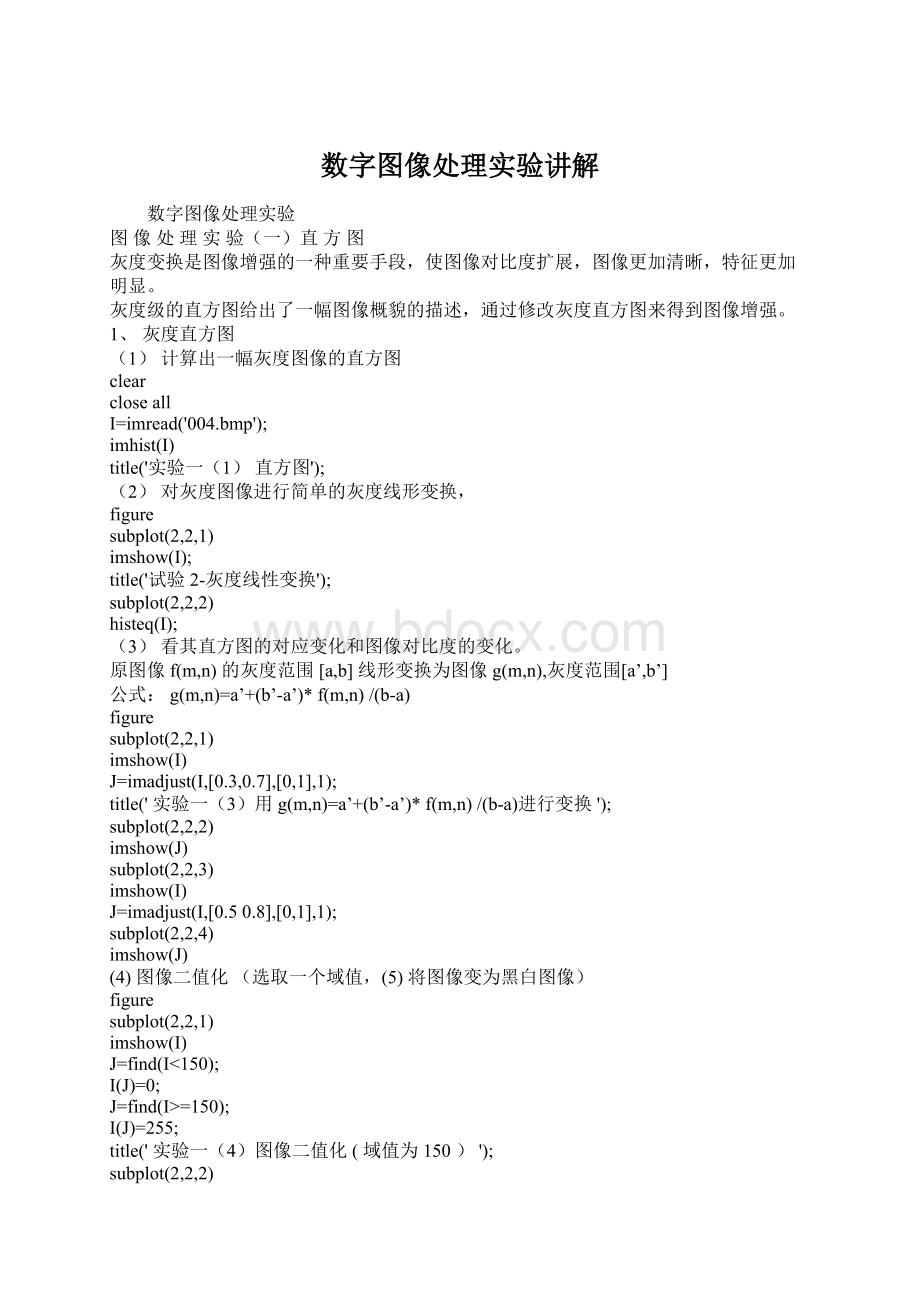数字图像处理实验讲解.docx
《数字图像处理实验讲解.docx》由会员分享,可在线阅读,更多相关《数字图像处理实验讲解.docx(10页珍藏版)》请在冰豆网上搜索。

数字图像处理实验讲解
数字图像处理实验
图像处理实验
(一)直方图
灰度变换是图像增强的一种重要手段,使图像对比度扩展,图像更加清晰,特征更加明显。
灰度级的直方图给出了一幅图像概貌的描述,通过修改灰度直方图来得到图像增强。
1、灰度直方图
(1)计算出一幅灰度图像的直方图
clear
closeall
I=imread('004.bmp');
imhist(I)
title('实验一
(1)直方图');
(2)对灰度图像进行简单的灰度线形变换,
figure
subplot(2,2,1)
imshow(I);
title('试验2-灰度线性变换');
subplot(2,2,2)
histeq(I);
(3)看其直方图的对应变化和图像对比度的变化。
原图像f(m,n)的灰度范围[a,b]线形变换为图像g(m,n),灰度范围[a’,b’]
公式:
g(m,n)=a’+(b’-a’)*f(m,n)/(b-a)
figure
subplot(2,2,1)
imshow(I)
J=imadjust(I,[0.3,0.7],[0,1],1);
title('实验一(3)用g(m,n)=a’+(b’-a’)*f(m,n)/(b-a)进行变换');
subplot(2,2,2)
imshow(J)
subplot(2,2,3)
imshow(I)
J=imadjust(I,[0.50.8],[0,1],1);
subplot(2,2,4)
imshow(J)
(4)图像二值化(选取一个域值,(5)将图像变为黑白图像)
figure
subplot(2,2,1)
imshow(I)
J=find(I<150);
I(J)=0;
J=find(I>=150);
I(J)=255;
title('实验一(4)图像二值化(域值为150)');
subplot(2,2,2)
imshow(I)
clc;
I=imread('14499.jpg');
bw=im2bw(I,0.5);%选取阈值为0.5
figure;
imshow(bw)%显示二值图象
图象处理变换
(二)
1.傅立叶变换
熟悉其概念和原理,实现对一幅灰度图像的快速傅立叶变换,并求其变换后的系数分布.
2.离散余弦变换
熟悉其概念和原理,实现对一幅灰度和彩色图像作的离散余弦变换,选择适当的DCT系数阈值对其进行DCT反变换.
%图象的FFT变换
clc;
I=imread('005.bmp');
subplot(1,2,1)
imshow(I);
title('原图');
subplot(1,2,2)
imhist(I);
title('直方图');
colorbar;
J=fft2(I);
figure;
subplot(1,2,1)
imshow(J);
title('FFT变换结果');
subplot(1,2,2)
K=fftshift(J);
imshow(K);
title('零点平移');
figure;
imshow(log(abs(K)),[]),colormap(jet(64)),colorbar;
title('系数分布图');
%图象的DCT变换
RGB=imread('005.bmp');
figure;
subplot(1,2,1)
imshow(RGB);
title('彩色原图');
a=rgb2gray(RGB);
subplot(1,2,2)
imshow(a);
title('灰度图');
figure;
b=dct2(a);
imshow(log(abs(b)),[]),colormap(jet(64)),colorbar;
title('DCT变换结果');
figure;
b(abs(b)<10)=0;
%idct
c=idct2(b)/255;
imshow(c);
title('IDCT变换结果');
图象处理变换(三)小波变换
实验内容:
熟悉小波变换的概念和原理,熟悉matlab小波工具箱主要函数的使用.利用二维小波分析对一幅图象作2层小波分解,并在此基础上提取各层的低频信息实现图像的压缩.
程序如下:
clc
closeall
clear
a=imread('005.bmp');
subplot(1,2,1);
imshow(a);
title('原始图象');
I=rgb2gray(a);
subplot(1,2,2);
imshow(I);
title('原始图象的灰度图');
%进行二维小波变换
[a,b]=wavedec2(I,2,'bior3.7');
%提取各层低频信息
figure;
c=appcoef2(a,b,'bior3.7',1);
subplot(1,2,1);
imshow(c,[]);
title('一层小波变换结果');
d=appcoef2(a,b,'bior3.7',2);
subplot(1,2,2);
imshow(d,[]);
title('二层小波变换结果');
图象处理实验(四)模板运算
一、实验内容:
(1)平滑:
平滑的目的是模糊和消除噪声。
平滑是用低通滤波器来完成,在空域中全是正值。
(2)锐化:
锐化的目的是增强被模糊的细节。
锐化是用高通滤波器来完成,在空域中,接近原点处为正,在远离原点处为负。
利用模板进行图象增强就是进行模板卷积。
1、利用二个低通邻域平均模板(3×3和9×9)对一幅图象进行平滑,验证模板尺寸对图象的模糊效果的影响。
2、利用一个低通模板对一幅有噪图象(GAUSS白噪声)进行滤波,检验两种滤波模板(分别使用一个5×5的线性邻域平均模板和一个非线性模板:
3×5中值滤波器)对噪声的滤波效果。
3、选择一个经过低通滤波器滤波的模糊图象,利用sobel和prewitt水平边缘增强高通滤波器(模板)对其进行高通滤波图象边缘增强,验证模板的滤波效果。
4、选择一幅灰度图象分别利用一阶Sobel算子和二阶Laplacian算子对其进行边缘检测,验证检测效果。
二、实验步骤:
1、利用低通邻域平均模板进行平滑:
I=imread('girl.bmp');
subplot(1,3,1);
imshow(I);
title('原图');
J=fspecial('average');
J1=filter2(J,I)/255;
subplot(1,3,2);
imshow(J1);
title('3*3滤波');
K=fspecial('average',9);
K1=filter2(K,I)/255;
subplot(1,3,3);
imshow(K1);
title('9*9滤波');
2、中值滤波和平均滤波
I=imread('girl.bmp');
J=imnoise(I,'gaussian',0,0.01);
subplot(2,2,1);
imshow(I);
title('原图');
subplot(2,2,2);
imshow(J);
title('noise');
K=fspecial('average',5);
K1=filter2(K,J)/255;
subplot(2,2,3);
imshow(K1);
title('average');
L=medfilt2(J,[35]);
subplot(2,2,4);
imshow(L);
title('medium');
3、高通滤波边缘增强
I=imread('girl.bmp');
subplot(2,2,1);
imshow(I);
title('originalpic');
J=fspecial('average',3);
J1=conv2(I,J)/255;
%J1=filter2(J,I)/255;
subplot(2,2,2);
imshow(J1);
title('3*3lowpass');
K=fspecial('prewitt');
K1=filter2(K,J1)*5;
subplot(2,2,3);
imshow(K1);
title('prewitt');
L=fspecial('sobel');
L1=filter2(L,J1)*5;
subplot(2,2,4);
imshow(L1);
title('sibel');
4、边缘检测
分别用sobel和laplacian算子来进行,程序如下:
I=imread('girl.bmp');
subplot(1,3,1);
imshow(I);
title('originalpic');
K=fspecial('laplacian',0.7);
K1=filter2(K,I)/100;
subplot(1,3,2);
imshow(K1);
title('laplacian');
L=fspecial('sobel');
L1=filter2(L,I)/200;
subplot(1,3,3);
imshow(L1);
title('sibel');
图像处理实验(五)图像分割
实验目的:
1、学习边缘检测
2、学习灰度阀值分割
实验内容:
1、分别用sobel、Laplacian-Gaussian方法对一幅灰度图像进行边缘提取,2、给出对比结果
i=imread('eight.tif');
figure;
subplot(2,2,1);
imshow(i);
title('原始图像');
subplot(2,2,3);
imshow(i);
title('原始图像');
i1=edge(i,'sobel');
subplot(2,2,2);
imshow(i1);
title('sober方法提取的边缘');
i2=edge(i,'log');
subplot(2,2,4);
imshow(i2);
title('Laplacian-Gaussian方法提取的边缘');
比较提取边缘的效果可以看出,sober算子是一种微分算子,对边缘的定位较精确,但是会漏去一些边缘细节。
而Laplacian-Gaussian算子是一种二阶边缘检测方法,它通过寻找图象灰度值中二阶过零点来检测边缘并将边缘提取出来,边缘的细节比较丰富。
通过比较可以看出Laplacian-Gaussian算子比sober算子边缘更完整,效果更好。
3、利用双峰法对一幅灰度图像进行灰度分割处理
i=imread('eight.tif');
subplot(1,2,1);
imhist(i);
title('原始图像直方图');
thread=130/255;
subplot(1,2,2);
i3=im2bw(i,thread);
imshow(i3);
title('分割结果');
根据原图像的直方图,发现背景和目标的分割值大约在130左右,并将灰度图像转为二值图像,分割效果比较理想。
图像处理实验(六)图像压缩与编码
实验目的:
学习JPEG压缩编码
实验内容:
一.实现基本JPEG的压缩和编码分三个步骤:
1.首先通过DCT变换去除数据冗余;
2.使用量化表对DCT系数进行量化;
3.对量化后的系数进行Huffman编码。
具体源程序由主程序及两个子程序(DCT量化、Huffman编码)组成:
1.主程序
I=imread('autumn.ti